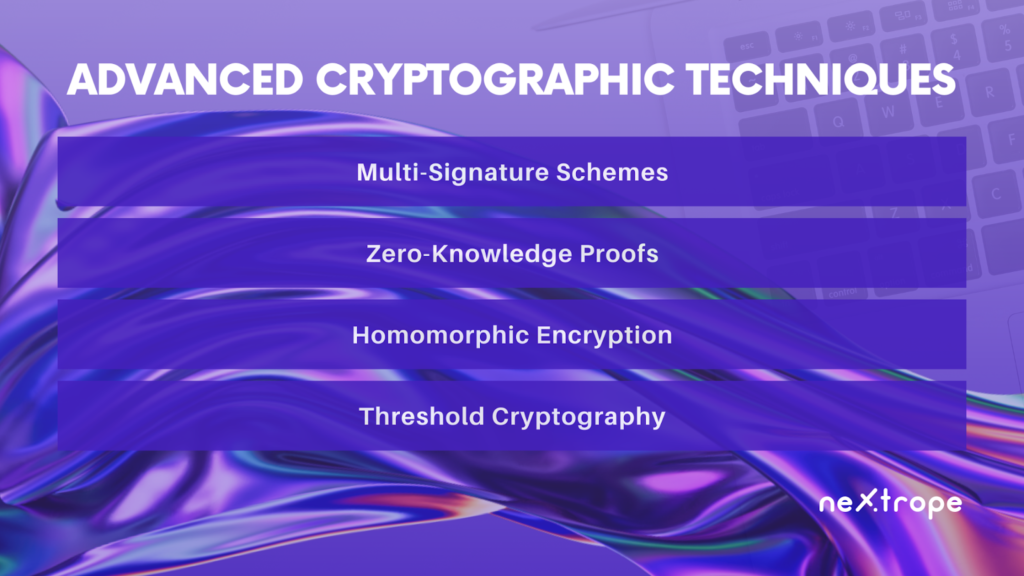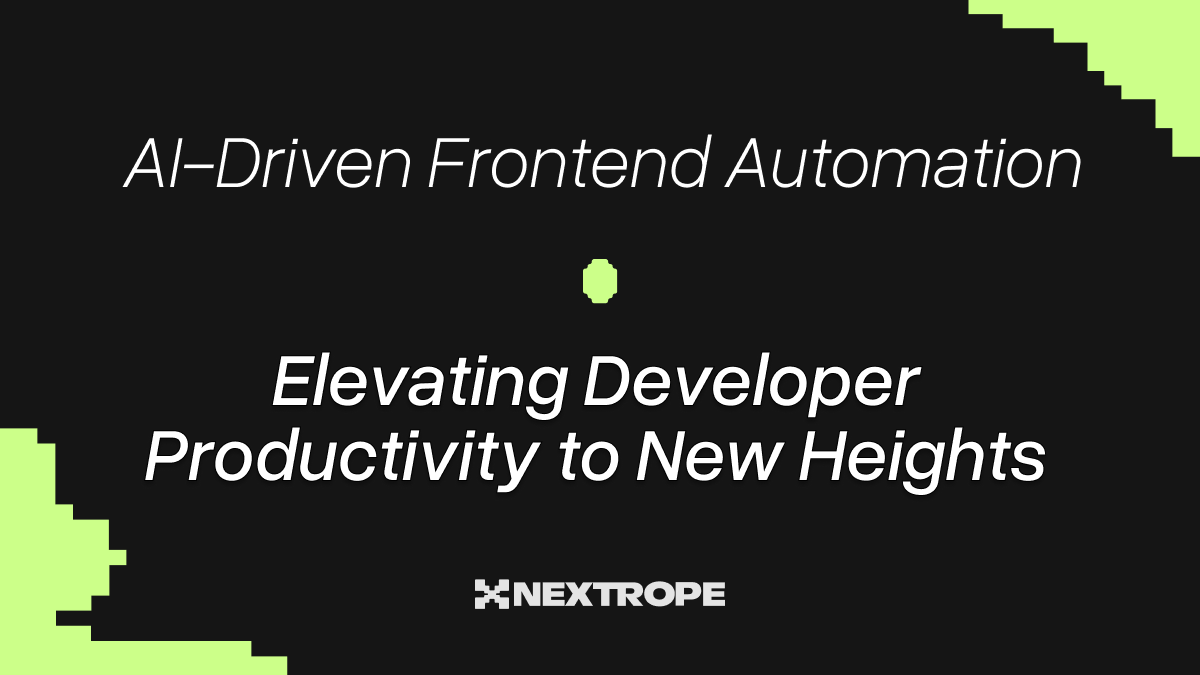The swift progression of blockchain technology has opened the door for inventive solutions in numerous industries. As blockchain gains prominence, it is critical to ensure the security of transactions and data stored on the blockchain. Cryptography is instrumental in attaining this security, offering strong encryption and authentication methods. This article emphasizes advanced cryptographic techniques for secure blockchain development, investigating how these approaches improve the integrity, confidentiality, and privacy of blockchain systems.
Understading Cryptography in Blockchain
At the core of secure communication and data protection in blockchain networks lies cryptography. By utilizing cryptographic algorithms, blockchain systems can guarantee the confidentiality of classified information and maintain transaction integrity. Three main types of cryptography are employed in blockchain: symmetric-key cryptography, asymmetric-key cryptography, and hash functions.
Symmetric-Key Cryptography
Also known as secret-key cryptography, symmetric-key cryptography employs a single key for both the encryption and decryption processes. This type of encryption is efficient and suitable for instances where the sender and receiver possess a shared key. However, securely transmitting the key between parties can present difficulties.
Symmetric-key cryptography has two categories: stream ciphers and block ciphers. Stream ciphers encrypt data bit by bit, continuously altering the encryption key. In contrast, block ciphers encrypt data in fixed-size blocks with identical plaintext blocks resulting in identical ciphertext blocks. Symmetric-key cryptography ensures that both sender and receiver know the key to facilitate secure communication.
Asymmetric-Key Cryptography
Asymmetric-key cryptography, alternatively known as public-key cryptography, uses a pair of keys: a public key and a private key. These keys have mathematical relations but deriving the private key from the public key is computationally impractical. The owner keeps the private key confidential while the public key is openly distributed.
For key exchange and authentication in blockchain systems, asymmetric-key cryptography is essential. One party creates a secret key and encrypts it with the recipient's public key. The recipient then decrypts the secret key using their private key, forming a secure connection. Asymmetric-key cryptography offers scalability and heightened security during data exchange involving multiple participants.
Hash Functions
Cryptographic algorithms called hash functions transform an input (plaintext) into a fixed-length output (hash value). Hash functions play a vital role in connecting blocks in a blockchain and ensuring data integrity. Determinism, preimage resistance, collision resistance, and speedy computation are among the properties of hash functions.
A hash function applied to data within a block results in a significantly distinct hash value if the data undergoes any modification. This feature, termed the avalanche effect, guarantees that even minor changes in block data lead to unrelated outputs. Hash functions render blockchain data dependable, secure, and resistant to tampering.
Gaining insight into these core cryptographic methods paves the way for examining advanced techniques that further enhance blockchain system security. Subsequent sections delve into advanced cryptographic techniques such as multi-signature schemes, zero-knowledge proofs, homomorphic encryption, and threshold cryptography. These methods augment security, confidentiality, and scalability in blockchain development, protecting sensitive information and facilitating innovative applications.
More about Cryptography in Blockchain
Advanced Cryptographic Techniques for Secure Blockchain Development

With the ongoing evolution of blockchain technology, the significance of advanced cryptographic techniques has grown to address the increasing demand for improved security in blockchain development. These methods contribute additional layers of defense, ensuring data confidentiality, integrity, and privacy on the blockchain. Let's examine some advanced cryptographic techniques:
Multi-Signature Schemes
Also known as multi-sig, multi-signature schemes permit several parties to have joint control over an address or execute transactions on the blockchain. Requiring multiple digital signatures from distinct private keys to authorize actions contributes to enhanced security. Multi-signature schemes help blockchain systems lessen the likelihood of single-point failures and unauthorized access while offering strong protection against harmful activities.
Zero-Knowledge Proofs
These proofs enable a party (the prover) to demonstrate the validity of a statement to another party (the verifier) without divulging any extra information beyond the truth of the statement. Within the sphere of blockchain, zero-knowledge proofs deliver mechanisms for privacy preservation. Users can confirm transactions or execute calculations on encrypted data without exposing underlying sensitive details. This approach equips blockchain participants with privacy and maintains network integrity.
Check out top ZKP projects to watch in 2023
Homomorphic Encryption
This encryption method allows computations on encrypted data without requiring decryption. As a result, secure, privacy-preserving computation can occur on blockchain data. Employing homomorphic encryption lets blockchain systems conduct operations like aggregations and computations on encrypted data while keeping the confidential information intact. Such encryption improves data security and privacy, thus expanding opportunities for secure computation in blockchain applications.
Threshold Cryptography
This type of cryptography entails distributing private keys among multiple participants so that a specific threshold of participants must work together to carry out cryptographic operations. This process strengthens security by eliminating single points of failure and minimizing key compromise risks. Applications for threshold cryptography include secure key generation, cryptographic operations, and digital signature schemes—all vital aspects in maintaining strong security within blockchain networks.
Incorporating these advanced cryptographic techniques into the development of blockchain lays the foundation for dependable and secure decentralized applications. Utilizing advanced cryptography enables blockchain solutions to attain superior levels of security, privacy, and reliability, thus unveiling new potential for numerous industries.
Moreover, continuous research and innovation in cryptography introduce groundbreaking techniques to bolster blockchain security. Staying up-to-date with the latest advancements in cryptographic methods becomes essential as blockchain technology progresses to ensure optimal security and integrity within these systems.
Practical Implementations of Advanced Cryptographic Techniques in Blockchain
Safeguarding the security and integrity of blockchain systems is made possible by advanced cryptographic techniques, which have become essential across numerous industries. By addressing specific challenges and strengthening trust in decentralized networks, these techniques have been successfully applied in various real-world situations. Here are some prominent examples of how advanced cryptographic techniques have been utilized in the blockchain sector:
Enhanced Security in Supply Chain Management
Advanced cryptographic techniques are crucial for blockchain-based supply chain management solutions, ensuring the protection of data and validation of goods and information flow throughout the supply chain. Multi-signature schemes enable participants to confirm transactions and transfers with multiple parties' authorization, mitigating fraud or tampering risks. Zero-knowledge proofs provide privacy-preserving product authenticity and quality verification, while homomorphic encryption safeguards sensitive supply chain information like pricing or trade secrets. These cryptographic methods improve transparency, traceability, and responsibility within supply chain operations.
Authentication and Identity Management
Blockchain-based identity management systems use advanced cryptographic techniques to protect personal information, streamlining identity verification processes simultaneously. Individuals can verify their identity through zero-knowledge proofs without giving away excessive personal data. Threshold cryptography ensures that private key management is more secure and distributed, reducing identity theft or unauthorized access risks. This takes digital identity systems to the next level by providing increased privacy, data protection, and user control over personal details.
Smart Contracts and Financial Transactions
Cryptocurrencies and blockchain-based finance systems depend heavily on advanced cryptographic techniques for secure transactions and smart contract execution. Using multi-signature schemes helps heighten security around cryptocurrency wallets while facilitating transactions requiring multiple parties' participation. Regulatory compliance is maintained through zero-knowledge proofs that enable anonymous transactions, while homomorphic encryption secures sensitive financial information stored on the blockchain. As a result, these cryptographic methods facilitate secure, transparent, and auditable financial dealings within decentralized networks.
Read more about Security of Smart Contracts
Privacy Protection for Healthcare Systems
Blockchain healthcare technology takes advantage of advanced cryptographic techniques to maintain patient privacy while ensuring secure and efficient data sharing among healthcare providers. Zero-knowledge proofs enable organizations to validate patient information without exposing the actual data, protecting patient confidentiality. Meanwhile, homomorphic encryption provides a secure way to analyze and research encrypted medical records without compromising privacy. These methods contribute to data security, patient privacy, and increased interoperability in healthcare systems.
Voting and Governance Platforms
The effectiveness of blockchain voting and governance structures relies on the application of advanced cryptographic techniques to uphold the fairness and transparency of elections and decision-making processes. Multi-signature schemes necessitate several authorized signatures for vote validation, guaranteeing secure voting. Individual voter choices are kept confidential while proving eligibility and vote accuracy using zero-knowledge proofs. Moreover, threshold cryptography enables secure management of distributed keys, facilitating decentralized governance systems safely. These techniques improve verifiability, credibility, and resistance to tampering in governance mechanisms.
The successful implementation of advanced cryptographic techniques in these real-world scenarios reveals their ability to address diverse blockchain use cases' security, privacy, and trust challenges. By utilizing these methods, various sectors can exploit blockchain's full potential while ensuring optimal data protection and system integrity.
As blockchain technology evolves further, we can expect the range of applications for advanced cryptographic techniques to grow accordingly. This will lead to even more innovative solutions across areas such as supply chain management, identity authentication, financial services, healthcare provision, and governance frameworks. Adopting these methods nurtures a more reliable, transparent, and trust-based decentralized environment that benefits organizations and individuals.
Conclusion
To sum up, the security and integrity of blockchain systems rely heavily on advanced cryptographic techniques. Utilizing methods such as multi-signature schemes, zero-knowledge proofs, homomorphic encryption, and threshold cryptography allows organizations to boost the trust in their blockchain solutions. These advanced cryptographic techniques have practical applications across various sectors, including supply chain management, identity management, finance, healthcare, and governance. Adopting cutting-edge cryptography is essential for staying ahead in the ever-evolving blockchain landscape and fostering trust within decentralized networks. By effectively leveraging these techniques, we can unleash the full potential of blockchain technology and lay the foundation for a safer and more decentralized future.
Would you like to build your own project on Blockchain? Contact us!
 en
en  pl
pl 











